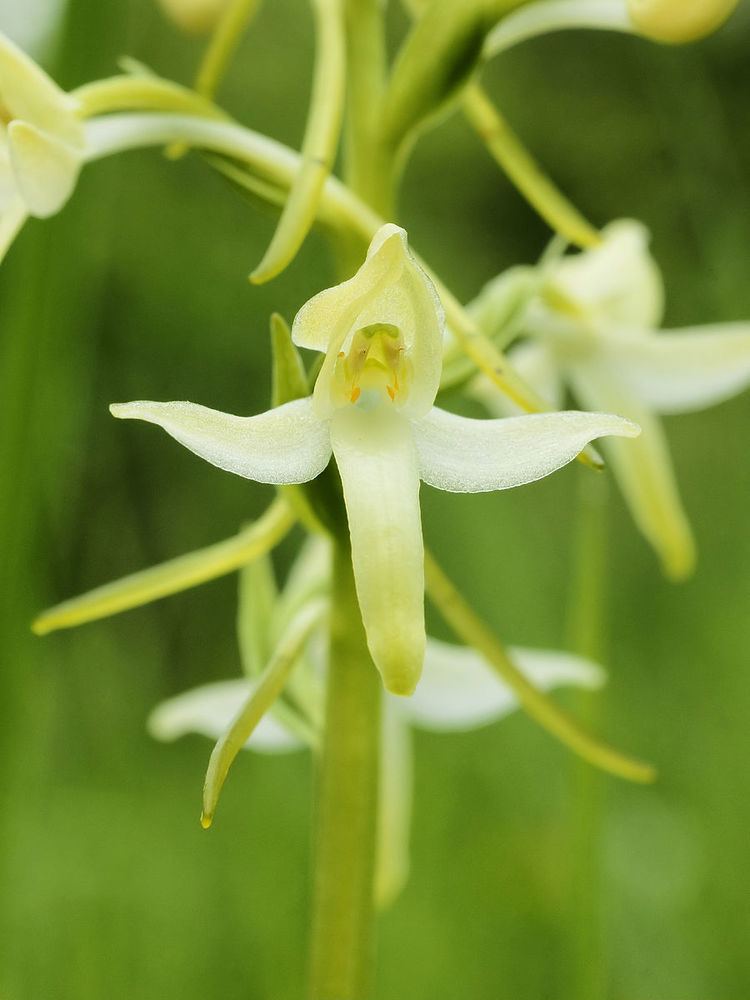Family Orchidaceae Subtribe Orchidinae | Genus PlatantheraRich. | |
 | ||
The genus Platanthera belongs to the subfamily Orchidoideae of the family Orchidaceae, and comprises about 100 species of orchids. The members of this genus, known as the butterfly orchids or fringed orchids, were previously included in the genus Orchis, which is a close relative (along with the genus Habenaria). They are distributed throughout the temperate regions of the Northern Hemisphere. They are terrestrial and have tubercules.
Contents
Etymology
Orchids get their name from the Greek word "orchis", meaning "testicle", based on the appearance of the underground tubercles in some terrestrial species. The word "orchis" was used by Theophrastus for the first time (371/372 – 287/286 B.C.), in his book "De Historia Plantarum" (On the Natural History of Plants). He was student of Aristotle and it is considered the father of botany and ecology.
Louis Claude Richard chose the name Platanthera for this genus; it comes from the Greek and means "broad or wide anther," referring to the separation of the base of the pollinia in the type species of the genus. Richard felt that this characteristic distinguished the genus Platanthera from both the genus Orchis and the genus Habenaria. However, today the defining characteristics of the genus are generally accepted to be the absence of both stigmatic processes (typical in Habenaria) and ovoid root-tuberoids (characteristic of both Habenaria and Orchis). Still, P. nivea, P. clavellata and P. integra all have stigmatic processes, showing the limitations of morphological characteristics in defining this clade.
Range
Orchids may be found distributed about the subarctic and temperate zones of the Northern Hemisphere: from Scandinavia to North Africa, the Azores, Madeira, Iceland, Asia Minor, Russia, the Himalayas, North America and Alaska. Areas of particular diversity include North America, with 32 species, and eastern Asia, with a similar number of species.
Description and habitat
Species of Platanthera are perennial terrestrial herbs, erect in habit. The roots are fasciculate and typically fleshy and slender, although they may be somewhat tuberous; if tuberous they are lanceolate to fusiform and not ovoid. The leaves are generally fleshy and range from oblong or ovoid to lanceolate. Leaf shape often varies with the lower leaves more ovoid in shape, progressively becoming more lanceolate as they progress up the scape; floral bracts, if present, are lanceolate to linear. The base of the leaves typically sheathes the stem. The inflorescence is terminal and solitary, and the flowers form a cylindrical spike that ranges from sparse to dense. The flowers are typically resupinate, and often showy and colorful. The petals and labellum are typically entire, but in a number of North American species they may be fringed or edentate; in this group of species the labellum is also often deeply lobed or auricuate. The seed capsules are cylindrical and ridged.
These terrestrial orchids develop in a wide range of soil types and habitats, from strongly basic soils to deeply acidic bog soils, from forest openings and in clearings within the forest to open tundra. In all cases they require moist soils and are not found in dry or desert locations. While their fleshy tuberculous roots can store water, allowing them to survive temporary drought, they cannot survived extended drought.
Platanthera may be distinguished from Orchis and Habenaria by the absence of stigmatic processes, and the absence of ovoid roots.
Species
Many species can cross-fertilise, resulting in great morphological variety and complicating classification.
The type species is Platanthera bifolia. More than 400 species, subspecies, and varieties have been described, and a 1997 study estimated around 85 species were clearly defined, though these quantities vary considerably between evolving classification systems, and naturally change as specimens are reanalyzed or newly acquired. "Species of Platanthera occur in North America, Asia, Europe, North Africa, Borneo, and Sarawak. Major centers of diversity are found in North America and East Asia."
These include 52 species from temperate Asian countries (China, Japan, Korea, Taiwan), 13 species from tropical Asian countries (Burma, Indonesia, Papua New Guinea, the Philippines), 37 species from North America north of Mexico, 7 species from Europe.
They include:
